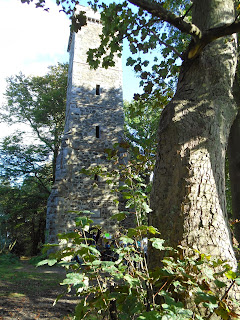The Tower celebrated its 130th anniversary in the year 2002. A year later, in 2003, the Tower saw another milestone in its history, the 70th anniversary of its official handing over to the then Edinburgh Corporation. The Tower was repaired and opened to the general public after agreement with the owners of the land around the Tower that they would give ground for access, free, provided the Corporation would erect an iron fence to separate it from their property. Another repair and re-opening in 2003, this time after vandals damaged the Tower in April 2002. It was carefully restored, at an approximate cost of £5,000. The doors were opened to visitors again, with Corstorphine Hill Tower taking its rightful place among the 180 buildings and monuments owned by the City of Edinburgh Council. It may jostle for prominence on the hill these days but it justifies a prominent place in our hearts.
Corstorphine Hill Tower (also known as Clermiston Tower or the Scott Tower) is a memorial to Sir Walter Scott. The tower, built on glaciated dolerite, is square in plan, with buttressed corners; it has a corbelled, battlemented parapet surmounted by a small tower. It is built of coursed whinstone, likely to be from quarries on the hill, with dressed sandstone for the openings, parapets and plaques, probably from one of the large Edinburgh sandstone quarries.
Corstorphine Hill is only 531 feet (161 metres) high. However, from all angles it presents a long low wood-covered ridge, rising above the western suburbs of Edinburgh: Corstorphine, Blackhall Murrayfield and Balgreen. Corstorphine Hill is readily identified by its distinctive Tower, now somewhat dominated by two aircraft communication pylons.
The ridge is L-shaped, running both north to south and west to east. Corstorphine Hill owes its prominent shape and its useful minerals to the geological processes which formed it over 340 million years. The geological story of the Making of Corstorphine Hill is given on the geology pages.
Because of its accessible rocks and its interesting landforms, Corstorphine Hill has been designated as a Regionally Important Geological Site (RIGS). The Hill has also been designated as a Local Nature Reserve, because of the colonies of badgers. It is one of Edinburgh's largest Public Parks, managed by the Ranger Service, assisted by the Friends of Corstorphine Hill.
The tree-cover makes finding view-points difficult; however, there are several good locations for each side of the hill, and when the tower is open to the public, a magnificent all-round view can be obtained from the top.
Corstorphine Hill Tower (also known as Clermiston Tower or the Scott Tower) is a memorial to Sir Walter Scott. The tower, built on glaciated dolerite, is square in plan, with buttressed corners; it has a corbelled, battlemented parapet surmounted by a small tower. It is built of coursed whinstone, likely to be from quarries on the hill, with dressed sandstone for the openings, parapets and plaques, probably from one of the large Edinburgh sandstone quarries.
Edinburgh Zoo makes use of the steep southern slopes of Corstorphine Hill. Also located on these slopes are the Corstorphine and Murrayfield hospitals, The Post House Hotel and St Anne's Church.
As well as the mansions of Clerwood and Hillwood, the western slopes are home to Queen Margaret College, Fox Covert Primary School, The Capital Moat House Hotel and St Andrews Church.













No comments:
Post a Comment